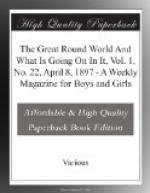But you must know how England became England, how France came to be France, and Germany Germany. And yet you cannot know one of these things unless you know about the Roman Empire too, which like an old dead root underlies the greater part of Europe.
Now I am going to tell you about the Ottoman Empire, or Turkey. And yet I find I must begin by talking about other things, and chiefly about that old dead Roman Empire, with which everything else is tangled up.
It was during the reign of Augustus Caesar, the first Roman Emperor, that Christ was born. So the Roman Empire was always just the age of the Christian era.
For the first three centuries, and while it was fiercely fighting the new Christianity, its power seemed invincible. It spread upon every side, toward the East as far as Asia, and in the West as far as the Atlantic. Gaul (or France and Spain) and Britain were gathered in by this insatiable power.
But the Romans could not conquer Germany. Instead of that, the Germans or Goths were always pressing down into Italy, and even thundered at the gates of Rome.
So harassed were the Romans by these terrible barbarians that at last they could no longer spare their legions in distant provinces. So Britain was dropped. And then, as she grew more decrepit and feeble, France got away from her too, and the Germans (who were already in Spain) took that fair land (France) into their own strong, rough keeping.
In the year 323, the Roman Emperor Constantine became a Christian. The Empire threw off its old Greek paganism and adopted Christianity.
Constantine determined to remove his capital far into the East, away from the terrible Goths. There was on the shores of the Bosphorus an old Greek city named Byzantion. This he chose for his capital, and called it Constantinople. So the Empire was divided into an “Eastern” and a “Western” Empire, with two Emperors, one at Rome and the other at Constantinople, or, as it was sometimes called, Byzantium.
Although the Empire was now richer in emperors, and had two Caesars instead of one, it rapidly became a mere shadow of what it once was; and all because of those terrible, ignorant, but iron-willed Goths, who not only would not be conquered, but were not satisfied until they had hammered to pieces the greatest Empire the world had ever seen.
The Eastern Empire with its beautiful Constantinople was in the country of the Ancient Greeks. The Greek language was the one spoken there; and while it had not the glory of the old imperial city of Rome, it had another sort of splendor.
It became the centre of the most brilliant intelligence of the world at that time. There were men great in learning, in art, in literature, and a polished civilization which was chiefly Greek and became less and less Roman.
All this was very dazzling in a way. But the days of the great ascendency of the Roman Empire were gone. A new star had arisen in the West.




